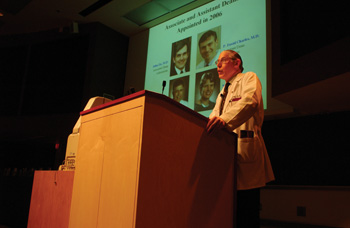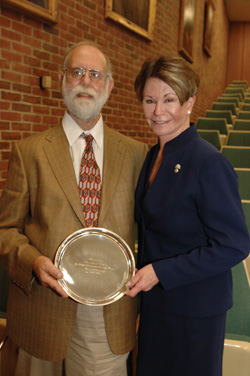
School of Medicine Dean Steven Gabbe, M.D., reviewed the school’s past year and looked to the future at Tuesday’s Spring Faculty Meeting. (photo by Mary Donaldson)
Spring Faculty Meeting highlights growth, future

Ken Wallston, Ph.D., professor of Psychology in Nursing at Vanderbilt University School of Nursing, and VUSN Dean Colleen Conway-Welch, Ph.D., show off the Joe B. Wyatt Distinguished University Professor Award presented to Wallston at this week’s Spring Faculty Meeting. (photo by Anne Rayner)
Significant growth in both faculty and funding for program development at Vanderbilt University School of Medicine has Dean Steven Gabbe, M.D., focused on the future as he embarks on his seventh year at the helm of one of the nation's top medical schools.
Gabbe positioned his speech at Tuesday's annual Spring Faculty Meeting around the five elevate pillars — people, service, quality, growth and finance — while reflecting on VUSM accomplishments over the past year as well as a look toward the future.
The mission, he said, is very simple — to have the best students educated by the best faculty in the best environment.
“We've grown. Since 2001, we have increased our numbers from 1,170 full-time faculty by nearly 600, or 51 percent, to 1,767 faculty,” Gabbe said.
“During that time we have increased our program development dollars from $14.3 million in 2001 to $26 million this past year and, for FY'08, it will be $28 million to support these programs. The yield from this investment has been quite astounding.”
A new nationwide faculty evaluation process, the Faculty Scholarly Productivity Index Academic Analytics, recently placed VUMC seventh overall among 166 large research universities.
Individual departments excelled within that ranking, including Pharmacology (first), Neuroscience (second), Genetics and Physiology (third).
Gabbe also used the elevate pillars to identify future challenges, with NIH funding, bridge funding, need-based scholarships and TennCare reimbursement listed as areas of concern under the Finance pillar.
Implementing the final stages of the new medical school curriculum was listed as a challenge under the Quality pillar, as first-year students begin the new integrated class system this August.
“The change has been to integrate our basic sciences, and teach our basic sciences, in a much more clinical-context, case-based context,” Gabbe said.
Completing and occupying new facilities was listed as a challenge under Growth, with several ongoing building projects on campus currently under way, including a $4 million, state-of-the-art gross anatomy laboratory in the recently completed Institute for Imaging Science.
Gabbe also presented a concept drawing of the Vanderbilt Oaks Wellness Center, an expansion plan currently in negotiations at 100 Oaks Mall off Thompson Lane in the Berry Hill area.
Leadership searches were listed as a priority under the People pillar, with several changes and transitions throughout the Medical Center.
In the category of students, the Class of 2011 currently boasts 4,787 applications, with 19 percent of those students interviewing. Of the 272 students accepted, 20 fall into the underrepresented in medicine (UR) category. The mean MCAT score is currently 11.7 for the new class and GPA is 3.79.
This year's Match Day for Vanderbilt students was also highlighted, with Gabbe noting that 25 students are returning to Vanderbilt for their residencies and 11 matched with Harvard Hospitals. The University of California selected seven VUSM students, University of Washington, five, Washington University, five and Duke four.
Before the meeting, official business was conducted for the Faculty Advisory Council, which voted unanimously to extend the term length for the positions of chair and vice chair from one year to two years to allow for more effective program planning.













